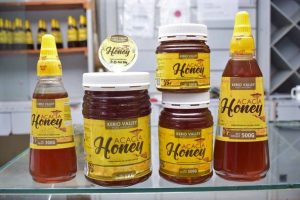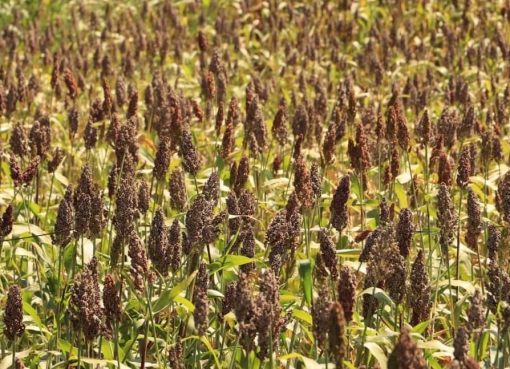BeeKeepers in the North Rift region will receive a major boost from Sh 60 million set aside by the Kerio Valley Development Authority as payout for crude honey this year.
More than six bee-keeping cooperative societies, particularly in West Pokot and Baringo counties have been identified to supply the honey that will be purchased and processed by KVDA.

KVDA Managing Director Sammy Naboros said they expect to purchase 100 tons of honey during the season adding that the authority buys the honey only from organised cooperatives and not individuals.
“We only buy our honey from cooperative societies who are our main suppliers of semi-processed honey. The Cooperative is able to collect between 10 and 20 tons of honey from farmers and sell to us in bulk,” explained Naboros.
He however said the honey is taken through rigorous tests before being purchased for processing at the Authorities processing plant in Rokocho, Elgeyo Marakwet County.
Naboros said the Ministry of Agriculture through the Livestock department works closely with KVDA in continuously training and sensitising honey farmers in the region on the kind of honey that is good for processing.
“Some farmers sometimes try to import honey from Uganda for sale to KVDA, but fail the KVDA test and it has to be taken back,” he says.
The Honey from West Pokot and parts of Baringo counties have been identified to be the best because of its unique Acacia taste.
“Honey from the various regions have different tests due to the flora and fauna, but the West Pokot and Baringo honey has the unique Acacia taste because of the Acacia nectar the bees use to make the honey,” explained the MD during an interview with KNA in his Eldoret office.
The MD said it was unfortunate that though the country has the potential to produce 100,000 tons of honey annually, only 20% is achieved making the country remain a net importer of honey.
“We import 50% of the honey we utilise in the country annually from the United States, Australia, and Tanzania,” he said.
He however said the authority was working on a programme in conjunction with the department of livestock on how to upscale honey production in six sub-counties in the North Rift region.
The programme, according to Naboros targets to increase honey production to one million metric tons annually with a focus on honey export in the future.
To increase the production of honey in the region, KVDA is supporting farmers to buy modern beehives at an affordable price to ensure the increased quantity and quality of honey produced in the region.
The MD said modern beehives will assure beekeepers of higher production of quality honey adding that they are also training bee farmers on improved techniques of beekeeping through their cooperative societies.
“Our challenge is that majority of our farmers still use the traditional beehives whose production, both in quantity and quality is very low. 80% of beehives used by beekeepers in the region are the traditional log hives,” he said.
The MD said honey production in the region covered by KVDA was based on the traditional log but in the recent past enormous effort has been put to promote honey production using modern beehives, despite the efforts put in place by various stakeholders in the beekeeping industry to modernize the methods of production not much impact has been achieved.
“We are however seeing some change, over the last five years KVDA alone has produced more than 5,000 modern beehives most of which are in use in the region,” he explained.
He said that KVDA was modernizing its honey processing plant that is the largest in the country with support from IFAD, adding “once we have back to back automation of the processing plant, and with all other factors in place, we shall be able to process up to 250tons of honey annually”.
Naboros further said they were focusing on value addition so that farmers can earn more from their honey. “We are currently buying honey from farmer cooperatives, process, package and distributing in the market, but once our value addition programme is achieved in the next two years, our involvement will end at processing and packaging, and leave the private sector players to do the distribution,” said the MD.
The MD said the government through the regional authorities was committed to promoting the small stock, Bees, and Fish for increased income generational and nutritional support to the communities.
Apart from promoting beekeeping, KVDA is also in the process of restocking Turkwel Dam with 1000 fish fingerlings at a cost of Sh 5 million.
“We have already stocked the dam with 300,000 fingerlings in conjunction with the University of Eldoret. The local community has agreed with KVDA to have the dam closed for the next six months’ growth and multiplication of the fish and we expect that in the next two years the dam will have 10 million fish,” said Naboros.
He said they were buying each fingerling at Sh.5 from the Lake Basin Development Authority and hoped that farmers will be able to sell the fish between Sh. 150 and Sh. 200.
The main types of beehives used in the beekeeping industry include Kenya top bar hive, Langstroth, and Super log hive.
The Kenya top bar hive according to KVDA information site was originally designed in Kenya in the late 1960’s for the Kenyan conditions. It is a transitional hive suitable for beekeepers as it is an improvement of the traditional log hives.
The hive consists of one chamber with 26 top bars and top lid covered with corrugated iron sheet. It has a capacity to produce 15-20kgs of honey per harvest with about 45% occupation in arid and semi-arid land (ASAL) areas.
On the other hand, the Langstroth has a Floor – Brood chamber with ten self-spacing frames – Queen Excluder – Super chamber with 10-11 shelves and has 20-30% Occupancy in the best conditions in the ASAL areas. In the medium to high altitude conditions, it produces 30-40 kgs of honey per harvest while in ASAL conditions it produces 10 kgs of honey per harvest.
The super log hive is an improvement of the traditional log hive. It is made from a hollow wooden log which is split lengthwise into two parts. The internal framework has wax rings which offer a foundation room where the bees start constructing honeycombs. Hive occupancy is about 75-79% in arid and semi-arid lands. It has the capacity to produce 18-20 kgs of honey per harvest.
By Kiptanui Cherono





